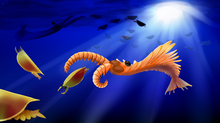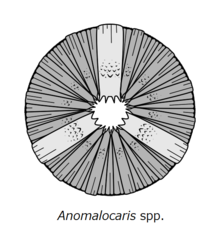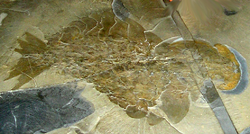アノマロカリス科
| アノマロカリス科 | ||||||||||||||||||||||||
|---|---|---|---|---|---|---|---|---|---|---|---|---|---|---|---|---|---|---|---|---|---|---|---|---|
 アノマロカリスの復元図
| ||||||||||||||||||||||||
| 地質時代 | ||||||||||||||||||||||||
| 古生代カンブリア紀第三期 - ガズハンジアン期(約5億1,800万[1] - 4億9,900万年前[2]) | ||||||||||||||||||||||||
| 分類 | ||||||||||||||||||||||||
| ||||||||||||||||||||||||
| 学名 | ||||||||||||||||||||||||
| Anomalocarididae Raymond, 1935[4] | ||||||||||||||||||||||||
| タイプ属 | ||||||||||||||||||||||||
| アノマロカリス属 Anomalocaris Whiteaves, 1892[5] | ||||||||||||||||||||||||
| 和名 | ||||||||||||||||||||||||
| (狭義の)アノマロカリス類[6][注釈 1] | ||||||||||||||||||||||||
| 英名 | ||||||||||||||||||||||||
| Anomalocaridid [7][注釈 1] Anomalocaridid radiodont [8] | ||||||||||||||||||||||||
| 属 | ||||||||||||||||||||||||
|
本文も参照
|
アノマロカリス科(Anomalocarididae[4])は、ラディオドンタ類の節足動物を大きく分けた分類群(科)の一つ[9][7]。約5億年前のカンブリア紀に生息したアノマロカリスなどが分類され、長い触手様の前部付属肢をもつ種類が含まれる[10][11][7]。
本科はアノマロカリス類[6](anomalocaridid[12][13][14][6][7][15][16])と総称されるが、かつてラディオドンタ類の全ての構成種を含んだ[17][18][19][20][21]ため、これらの呼称は一時期では本科の構成種のみ(狭義のアノマロカリス類)ならず、ラディオドンタ類全般の別名でもあった(広義のアノマロカリス類、後述)[17][18][19][20][21][22][23][24]。
経緯[編集]
アノマロカリス科はラディオドンタ類における4つの科[注釈 2]の一つであり、その中でも本科は唯一に21世紀以前で創設されたものである[注釈 3][4][9]。学名「Anomalocarididae」(「Anomalocaridae」と表記されることもある[21])は、本科の模式属(タイプ属)であるアノマロカリス(Anomalocaris[5])に因んで名付けられた[4]。
なお、創設当初(Raymond 1935[4])から1970年代にかけてラディオドンタ類の全貌と多様性は未解明で、本科もその頃ではまだ甲殻類と誤解釈されるアノマロカリス(アノマロカリス#発見史を参照)のみを含んでいた[4]。本科の模式属であるアノマロカリスは1980年代でラディオドンタ類であると判明したが、当時唯一に知られるラディオドンタ類であるアノマロカリスは科所属不明とされ、本科はその分類体系に採用されなかった[25]。1990年代では、ラディオドンタ類(Radiodonta)が創設され、本科もその下位分類群として再び採用されるようになったが、2010年代前期まででは、ラディオドンタ類の全ての構成種は本科のみに含まれた[17][18][19][20][21]。そのため、2010年代後期まででは、ラディオドンタ類全般は一般に「アノマロカリス類」(anomalocaridid)と総称された[17][18][19][20][21][22][23][24]。
しかし、ラディオドンタ類の構成種が Vinther et al. 2014 で本科含めて4つの科[注釈 2]を基に再分類された以降では、本科は一部のラディオドンタ類のみを含めるようになった[9]。例えば Wu et al. 2021a では、本科の構成種として認められるのはアノマロカリスとレニシカリス(Lenisicaris)の種類のみである[7]。これにより、ラディオドンタ類全般を指す総称も徐々にこの分類体系に反映した「radiodontan」[3][24][26][27][28][29][30][12][31][32]や「radiodont」[33][34][13][35][14][36][37][38][7][39][15][8]に変更され、前述の本科由来の総称「anomalocaridid」(アノマロカリス類)はラディオドンタ類全般ではなく、代わりに本科の種類のみを指すのに狭義化されつつある[12][13][14][6][7][15][16]。なお、この分類体系の中で、本科は系統学のみに基づいた(国際動物命名規約の条項的には無効である)定義のみ与えられ[注釈 4][9]、2021年現在では未だに他のラディオドンタ類の科から区別させるほど、形態学に基づいた有効の再定義がなされていない[注釈 5][7]。
特記しない限り、本項目は Wu et al. 2021a による、アノマロカリスとレニシカリスのみを含んだアノマロカリス科[7]について記述する。
形態[編集]
アノマロカリス科のラディオドンタ類の前部付属肢(frontal appendage)は十数節(柄部1-2節と残り13節[10][11][7][注釈 6][8])の肢節に分かれ、全体的に長い触手様の形をもつ[10][11][13][7]。柄部以降の各肢節は可動的で、背側1対の関節丘と腹面の三角形の節間膜を介して連結される[10][11][13][7]。少なくとも柄部と先端以外の肢節はそれぞれの腹側に1対の内突起(endite)があり、先端ほど短くなりながら長短を繰り返している[10][11][13][7]。例外もある[注釈 7][35]が、内突起の長さは原則として該当肢節の高さを超えない[35][7]。内突起のうち柄部直後の方が往々にして最も発達であるが、アンプレクトベルア科の種類ほど強大に特化した形ではない[7]。内突起は種類によって前後の縁にそれぞれ1本以上の分岐(auxiliary spine)をもつ(アノマロカリス)[40][10][11]、もしくは単純の棘状で分岐を欠く(レニシカリス)[35][7]。
-
Anomalocaris canadensis の全身復元図
前部付属肢以外の構造はアノマロカリスのみによって知られ、中でも全身が判明したのは Anomalocaris canadensis という1種のみである[注釈 8][41][42]。流線型な体をしており、小さな頭部にある3枚の甲皮はいずれも楕円形で目立たない[10][14]。口の歯(oral cone)は不規則な三放射状で、32枚を超えた総数不定の歯のうち、前方の1枚と両後方の2枚が最も大きく、小さな開口近くの表面にはうろこ状の隆起、外縁には溝が密生している[43][44][31]。十数節の胴節のうち、首のように短縮した前3節は退化的な鰭のみをもつ[10][45]。それ以降の13節は各胴節の横幅と同じほど発達した鰭をもち、ダイヤモンド形の輪郭を描くように3-4番目から後方ほど幅狭くなる[10]。鰓のような構造体(setal blades)は各胴節の背側で左右に別れて配置される[10]。尾部は3対の発達した尾鰭でできた尾扇(tail fan)をもつ[10][14]。
本科の流線型な体・小さな頭部と甲皮・歯の隆起と外縁の溝・前部付属肢の可動的な肢節と長短を繰り返した内突起は、ラディオドンタ類の中でアンプレクトベルア科の種類に共通した特徴である[32][13][14][8]。一方、本科の3対の尾鰭と歯における三放射構造は、知られるラディオドンタ類の中でそれぞれインノヴァティオカリスとタミシオカリス科のエキドナカリスのみに共通である[42][46]。
生態[編集]

アンプレクトベルア科の種類と同様、アノマロカリス科のラディオドンタ類は流線型の体・発達した鰭・頑丈な内突起をもつ前部付属肢により、フルディア科の種類より活動的で、獰猛な遊泳性捕食者であったと考えられる[24][34][32][38][7][47]。能動的な前部付属肢を下向きに湾曲し、活動的な獲物を巻き付けるように捕獲していたとされ[48][18][49][35][15][47]、小さな甲皮は、その可動域を制限せずに防御の役割を果たしていたと考えられる[27][32]。また、本科のアノマロカリスに見られる不規則で小さな開口部をもつ歯は、蠕虫状の柔らかい小動物を吸い込むのに向いたとされる[43][24]。発達した尾扇は、遊泳中の横安定性を維持することや急速な方向変更に用いられたと考えられる[50]。
分布と生息時代[編集]
ラディオドンタ類の中で、アノマロカリス科の化石標本は中国南部(雲南省[7]、湖南省[40])、北アメリカ(カナダ[5][48][51]、アメリカ[52][11][35])とオーストラリア[44]から発見され、次の通りに列挙される[7]。
本科としての本質が不確実の記録は「*」で示す。
- Maotianshan Shale(澄江動物群、中国、雲南省、約5億1,800万年前[1]):Anomalocaris cf. canadensis[7]、Anomalocaris sp. 1[17][7]/ラディオドンタ類 C[42]、Lenisicaris lupata[7]
- Hongjingshao Formation(Malong Fauna、中国、雲南省):Anomalocaris sp. 3 (Zhang et al. 2001 Fig. 3b)[53][7]
- Fandian biota(中国、四川省):YKLP 12377[54]
- Kinzers Formation(アメリカ、ペンシルベニア州):Lenisicaris pennsylvanica[52][35]、未命名種 (Thomas 2021)[56]
- Balang Formation(Balang Biota、中国、湖南省):Anomalocaris sp. 4 (NIGP 156214)[57]
- Emu Bay Shale(オーストラリア、カンガルー島):Anomalocaris daleyae[44][46]
- Eager formation(Cranbrook Shale、カナダ、ブリティッシュコロンビア州):Anomalocaris canadensis[52][48][58]
- カンブリア紀ウリューアン期(約5億900万 - 5億450万年前)
- Kaili Formation(Kaili Biota、中国、貴州省):*GTBM-9-1-1022[注釈 11][59][60][7][8]
- バージェス頁岩(バージェス動物群、カナダ、ブリティッシュコロンビア州、約5億1,000万 - 5億500万年前[61]):Anomalocaris canadensis[5]
- Stanley glacier(バージェス動物群、カナダ、ブリティッシュコロンビア州):Anomalocaris canadensis[51]
- カンブリア紀ドラミアン期(約5億450万 - 5億50万年前)
- Wheeler Shale(アメリカ、ユタ州):新属新種 (Halgedahl et al. 2009 Fig. 10L)[62]
- カンブリア紀ガズハンジアン期(約5億50万 - 4億9700万年前)
- Weeks Formation(アメリカ、ユタ州、約4億9,900万年前[2]):Anomalocaris aff. canadensis[11]、Anomalocaris sp. 6 (BPM 1034)[11]
分類[編集]
| |||||||||||||||||||||||||||
| ラディオドンタ類におけるアノマロカリス科(青枠)の系統関係(Moysiuk & Caron 2022 に基づく)[63] |
多くの系統解析では、ラディオドンタ類の中でアノマロカリス科は一般にアンプレクトベルア科の近縁とされ、フルディア科(フルディア、ペイトイアなど)やタミシオカリス科(タミシオカリスなど)とは別の単系統群を構成するとされる[9][22][23][34][32][15]。本科とアンプレクトベルア科は、流線型の体・小さな頭部と甲皮・捕食性に適した能動的な前部付属肢・内突起の長短繰り返し構造などの多くの共通点をもつが、そのほとんどが単にラディオドンタ類の祖先形質である可能性が高い[14][45][63]。また、本科を基盤的なラディオドンタ類[16][63]、もしくはタミシオカリス科の近縁とする解析結果もあり[42]、特に後者は同じ三放射状の歯の構造に示唆される[46]。
なお、アノマロカリス科の単系統性は不確実で[9][22][23][34][32][15][8][63][42]、その単系統性を支持する研究は Liu et al. 2018 による一部の系統解析結果[32]のみである[8]。これは主に本科のアノマロカリス(Anomalocaris)の雑多な内部構成が原因と思われ[8]、2020年代までの本属は、その模式種(タイプ種)である Anomalocaris canadensis より遠縁の可能性がある種を多く含んでいた。これにより、これらの種も再分類がなされつつあり、例えば Anomalocaris pennsylvanica[52] はレニシカリス(Lenisicaris)に[7]、 Anomalocaris saron[17] と Anomalocaris magnabasis[55] はホウカリス(Houcaris)に[39]、Anomalocaris sp. ELRC 20001 はインノヴァティオカリス(Innovatiocaris)に[42]、Anomalocaris briggsi はエキドナカリス(Echidnacaris)に分類されるようになった[46]。
Wu et al. 2021a[7] と Paterson et al. 2023[46] によると、正式の命名がなされたラディオドンタ類の中で、アノマロカリス科に含めるのは次の2属4種のみである。
なお、未命名種まで範囲を広げると、アノマロカリスは複数種の化石標本が含まれる[注釈 12][7]。また、パラノマロカリス(Paranomalocaris, 科の所属が不確実[7][8])[23][32][8]、ホウカリス(文献によりタミシオカリス科[39][15][63][42]もしくはアンプレクトベルア科[9][34]に分類される)、インノヴァティオカリス(原記載では科未定[42])、およびラムスコルディア(Ramskoeldia, 一般にアンプレクトベルア科に分類される[33][34][63])[42]の種類を本科に分類する見解もある[23][32][15][63]。
脚注[編集]
注釈[編集]
- ^ a b 「Anomalocaridid」と「アノマロカリス類」はアノマロカリス科のみならず、ラディオドンタ類(ラディオドンタ目 Radiodonta)の構成種全般を指す総称でもある。詳細はアノマロカリス科#経緯とラディオドンタ類#名称を参照。
- ^ a b アノマロカリス科 Anomalocarididae・アンプレクトベルア科 Amplectobeluidae・タミシオカリス科 Tamisiocarididae(="Cetiocaridae")・フルディア科 Hurdiidae
- ^ アノマロカリス科は Raymond 1935、アンプレクトベルア科とフルディア科は Vinther et al. 2014、タミシオカリス科(=Vinther et al. 2014 の "Cetiocaridae")は Pates & Daley 2018 に創設される。
- ^ アンプレクトベルア・シンブラキアタ Amplectobelua symbrachiata、タミシオカリス・ボレアリス Tamisiocaris borealis とフルディア・ヴィクトリア Hurdia victoria よりアノマロカリス・カナデンシス Anomalocaris canadensis に近縁の全ての種を含む。
- ^ Vinther et al. 2014 以前のアノマロカリス科の定義はその頃の分類体系を前提にしたものである。特に1990年代から2010年代前期までではアノマロカリス科の定義はラディオドンタ類全般に該当するため、それ以降に新設した他のラディオドンタ類の科から区別する効果はない。
- ^ ただしアノマロカリス科に含まれる可能性があるパラノマロカリス(Paranomalocaris)の前部付属肢は、柄部以降に20節ほどの肢節をもつ。
- ^ Lenisicaris pennsylvanica の多くの内突起は明らかに該当肢節の高さより長い。
- ^ かつてアノマロカリスと考えられた全身化石標本 ELRC 20001 は、Zeng et al. 2022 により本科でない種類(Innovatiocaris maotianshanensis)として再分類されるようになている。
- ^ Maotianshan Shale(澄江動物群、中国、雲南省、約5億2,000万年前)の Houcaris saron は本科に含まれる可能性がある。後述参照。
- ^ Pioche Shale と Pyramid shale(アメリカ、ネバダ州)の Houcaris magnabasis、および Wulongqing Formation(Guanshan biota、中国、雲南省)の Paranomalocaris multisegmentalis と Paranomalocaris simplex は本科に含まれる可能性がある。後述参照。
- ^ Zhao et al. (2005, 2011) と Wu et al. 2021a では本科のアノマロカリス(Anomalocaris sp. 5)、Jiao et al. 2021 ではアンプレクトベルア科(おそらくアンプレクトベルア)由来とされる。
- ^ Anomalocaris sp. 1 (Chengjiang)、Anomalocaris cf. canadensis (Emu Bay)、Anomalocaris sp. 3 (Malong)、? GTBM-9-1-1022 (Kaili)、Anomalocaris sp. 4 (Balang)、Anomalocaris aff. canadensis (Weeks)、Anomalocaris sp. 6 (Weeks)、Anomalocaris cf. canadensis (Chengjiang)
出典[編集]
- ^ a b c Yang, Chuan; Li, Xian-Hua; Zhu, Maoyan; Condon, Daniel J.; Chen, Junyuan (2018-07). “Geochronological constraint on the Cambrian Chengjiang biota, South China” (英語). Journal of the Geological Society 175 (4): 659–666. doi:10.1144/jgs2017-103. ISSN 0016-7649.
- ^ a b c Bonino, Enrico (2018-05-23) (英語). The Weeks Formation Konservat–Lagerstätte and the evolutionary transition of Cambrian marine life. doi:10.6084/m9.figshare.c.4109588.v1.
- ^ a b Ortega-Hernández, Javier (2016). “Making sense of ‘lower’ and ‘upper’ stem-group Euarthropoda, with comments on the strict use of the name Arthropoda von Siebold, 1848” (英語). Biological Reviews 91 (1): 255–273. doi:10.1111/brv.12168. ISSN 1469-185X.
- ^ a b c d e f RAYMOND, P. E. 1935. Leanchoilia and other mid-Cambrian Arthropoda. Bulletin of the Museum of Comparative Zoology, Harvard University, 76: 205–230.
- ^ a b c d e f g Whiteaves, Joseph Frederick (1892). Description of a new genus and species of phyllocarid Crustacea from the Middle Cambrian of Mount Stephen, B.C.. Canadian Record of Science, 5: 205-208.
- ^ a b c d 土屋, 健; かわさき, しゅんいち; 田中, 源吾 (2020) (Japanese). アノマロカリス解体新書. ISBN 978-4-89308-928-1. OCLC 1141813539
- ^ a b c d e f g h i j k l m n o p q r s t u v w x y z aa ab ac ad ae af Wu, Yu; Ma, Jiaxin; Lin, Weiliang; Sun, Ao; Zhang, Xingliang; Fu, Dongjing (2021-05-01). “New anomalocaridids (Panarthropoda: Radiodonta) from the lower Cambrian Chengjiang Lagerstätte: Biostratigraphic and paleobiogeographic implications” (英語). Palaeogeography, Palaeoclimatology, Palaeoecology 569: 110333. doi:10.1016/j.palaeo.2021.110333. ISSN 0031-0182.
- ^ a b c d e f g h i j k Jiao, De-guang; Pates, Stephen; Lerosey-Aubril, Rudy; Ortega-Hernandez, Javier; Yang, Jie; Lan, Tian; Zhang, Xi-guang (2021-06-02). “The endemic radiodonts of the Cambrian Stage 4 Guanshan biota of South China” (英語). Acta Palaeontologica Polonica 66. doi:10.4202/app.00870.2020. ISSN 0567-7920.
- ^ a b c d e f g Vinther, Jakob; Stein, Martin; Longrich, Nicholas R.; Harper, David A. T. (2014-03). “A suspension-feeding anomalocarid from the Early Cambrian” (英語). Nature 507 (7493): 496–499. doi:10.1038/nature13010. ISSN 1476-4687.
- ^ a b c d e f g h i j k l Daley, Allison C.; Edgecombe, Gregory D. (2014/01). “Morphology of Anomalocaris canadensis from the Burgess Shale” (英語). Journal of Paleontology 88 (1): 68–91. doi:10.1666/13-067. ISSN 0022-3360.
- ^ a b c d e f g h i Lerosey-Aubril, R.; Hegna, T.A.; Babcock, L.E.; Bonino, E.; Kier, C. (2014-05-19). “Arthropod appendages from the Weeks Formation Konservat-Lagerstätte: new occurrences of anomalocaridids in the Cambrian of Utah, USA”. Bulletin of Geosciences: 269–282. doi:10.3140/bull.geosci.1442. ISSN 1802-8225.
- ^ a b c Cong, Peiyun; Daley, Allison C.; Edgecombe, Gregory D.; Hou, Xianguang (2017-08-30). “The functional head of the Cambrian radiodontan (stem-group Euarthropoda) Amplectobelua symbrachiata”. BMC Evolutionary Biology 17 (1): 208. doi:10.1186/s12862-017-1049-1. ISSN 1471-2148. PMC 5577670. PMID 28854872.
- ^ a b c d e f g Pates, Stephen; Daley, Allison C.; Butterfield, Nicholas J. (2019-06-11). “First report of paired ventral endites in a hurdiid radiodont”. Zoological Letters 5 (1): 18. doi:10.1186/s40851-019-0132-4. ISSN 2056-306X. PMC 6560863. PMID 31210962.
- ^ a b c d e f g Moysiuk, J.; Caron, J.-B. (2019-08-14). “A new hurdiid radiodont from the Burgess Shale evinces the exploitation of Cambrian infaunal food sources”. Proceedings of the Royal Society B: Biological Sciences 286 (1908): 20191079. doi:10.1098/rspb.2019.1079. PMC 6710600. PMID 31362637.
- ^ a b c d e f g h Moysiuk, Joseph; Caron, Jean-Bernard (2021-05-17). “Exceptional multifunctionality in the feeding apparatus of a mid-Cambrian radiodont” (英語). Paleobiology: 1–21. doi:10.1017/pab.2021.19. ISSN 0094-8373.
- ^ a b c Caron, J.-B.; Moysiuk, J. (2021-09-08). “A giant nektobenthic radiodont from the Burgess Shale and the significance of hurdiid carapace diversity”. Royal Society Open Science 8 (9): 210664. doi:10.1098/rsos.210664.
- ^ a b c d e f Xian‐Guang, Hou; Bergström, Jan; Ahlberg, Per (1995-09-01). “Anomalocaris and other large animals in the lower Cambrian Chengjiang fauna of southwest China”. GFF 117 (3): 163–183. doi:10.1080/11035899509546213. ISSN 1103-5897.
- ^ a b c d e f Collins, Desmond (1996/03). “The “evolution” of Anomalocaris and its classification in the arthropod class Dinocarida (nov.) and order Radiodonta (nov.)” (英語). Journal of Paleontology 70 (2): 280–293. doi:10.1017/S0022336000023362. ISSN 0022-3360.
- ^ a b c d Daley, Allison C.; Budd, Graham E.; Caron, Jean-Bernard; Edgecombe, Gregory D.; Collins, Desmond (2009-03-20). “The Burgess Shale Anomalocaridid Hurdia and Its Significance for Early Euarthropod Evolution” (英語). Science 323 (5921): 1597–1600. doi:10.1126/science.1169514. ISSN 0036-8075. PMID 19299617.
- ^ a b c d Daley, Allison C.; Budd, Graham E.; Caron, Jean-Bernard (2013-10-01). “Morphology and systematics of the anomalocaridid arthropod Hurdia from the Middle Cambrian of British Columbia and Utah”. Journal of Systematic Palaeontology 11 (7): 743–787. doi:10.1080/14772019.2012.732723. ISSN 1477-2019.
- ^ a b c d e Wang, YuanYuan; Huang, DiYing; Hu, ShiXue (2013-11-01). “New anomalocardid frontal appendages from the Guanshan biota, eastern Yunnan” (英語). Chinese Science Bulletin 58 (32): 3937–3942. doi:10.1007/s11434-013-5908-x. ISSN 1861-9541.
- ^ a b c d Cong, Peiyun; Ma, Xiaoya; Hou, Xianguang; Edgecombe, Gregory D.; Strausfeld, Nicholas J. (2014-09). “Brain structure resolves the segmental affinity of anomalocaridid appendages” (英語). Nature 513 (7519): 538–542. doi:10.1038/nature13486. ISSN 1476-4687.
- ^ a b c d e f Van Roy, Peter; Daley, Allison C.; Briggs, Derek E. G. (2015-06). “Anomalocaridid trunk limb homology revealed by a giant filter-feeder with paired flaps” (英語). Nature 522 (7554): 77–80. doi:10.1038/nature14256. ISSN 1476-4687.
- ^ a b c d e De Vivo, Giacinto; Lautenschlager, Stephan; Vinther, Jakob (2016-12-16). Reconstructing anomalocaridid feeding appendage dexterity sheds light on radiodontan ecology.
- ^ Whittington, Harry Blackmore; Briggs, Derek Ernest Gilmor (1985-05-14). “The largest Cambrian animal, Anomalocaris, Burgess Shale, British-Columbia”. Philosophical Transactions of the Royal Society of London. B, Biological Sciences 309 (1141): 569–609. doi:10.1098/rstb.1985.0096.
- ^ Cong, Peiyun; Daley, Allison C.; Edgecombe, Gregory D.; Hou, Xianguang; Chen, Ailin (2016/07). “Morphology of the radiodontan Lyrarapax from the early Cambrian Chengjiang biota” (英語). Journal of Paleontology 90 (4): 663–671. doi:10.1017/jpa.2016.67. ISSN 0022-3360.
- ^ a b Zeng, Han; Zhao, Fangchen; Yin, Zongjun; Zhu, Maoyan (2018-01-02). “Morphology of diverse radiodontan head sclerites from the early Cambrian Chengjiang Lagerstätte, south-west China”. Journal of Systematic Palaeontology 16 (1): 1–37. doi:10.1080/14772019.2016.1263685. ISSN 1477-2019.
- ^ Pates, Stephen; Daley, Allison; Ortega-Hernández, Javier (2017). “Aysheaia prolata from the Wheeler Formation (Cambrian, Drumian) is a frontal appendage of the radiodontan Stanleycaris” (英語). Acta Palaeontologica Polonica 62. doi:10.4202/app.00361.2017. ISSN 0567-7920.
- ^ Pates, Stephen; Daley, Allison C.; Lieberman, Bruce S. (2017-07-24). “Hurdiid radiodontans from the middle Cambrian (Series 3) of Utah” (英語). Journal of Paleontology 92 (1): 99–113. doi:10.1017/jpa.2017.11. ISSN 0022-3360.
- ^ Pates, Stephen; Daley, Allison C. (2017-08-01). “Caryosyntrips: a radiodontan from the Cambrian of Spain, USA and Canada” (英語). Papers in Palaeontology 3 (3): 461–470. doi:10.1002/spp2.1084. ISSN 2056-2802.
- ^ a b Zeng, Han; Zhao, Fangchen; Yin, Zongjun; Zhu, Maoyan (2018/01). “A new radiodontan oral cone with a unique combination of anatomical features from the early Cambrian Guanshan Lagerstätte, eastern Yunnan, South China” (英語). Journal of Paleontology 92 (1): 40–48. doi:10.1017/jpa.2017.77. ISSN 0022-3360.
- ^ a b c d e f g h i Liu, Jianni; Lerosey-Aubril, Rudy; Steiner, Michael; Dunlop, Jason A; Shu, Degan; Paterson, John R (2018-06-01). “Origin of raptorial feeding in juvenile euarthropods revealed by a Cambrian radiodontan”. National Science Review 5 (6): 863–869. doi:10.1093/nsr/nwy057. ISSN 2095-5138.
- ^ a b Cong, Pei-Yun; Edgecombe, Gregory D.; Daley, Allison C.; Guo, Jin; Pates, Stephen; Hou, Xian-Guang (2018). “New radiodonts with gnathobase-like structures from the Cambrian Chengjiang biota and implications for the systematics of Radiodonta” (英語). Papers in Palaeontology 4 (4): 605–621. doi:10.1002/spp2.1219. ISSN 2056-2802.
- ^ a b c d e f Lerosey-Aubril, Rudy; Pates, Stephen (2018-09-14). “New suspension-feeding radiodont suggests evolution of microplanktivory in Cambrian macronekton” (英語). Nature Communications 9 (1): 3774. doi:10.1038/s41467-018-06229-7. ISSN 2041-1723. PMC 6138677. PMID 30218075.
- ^ a b c d e f g h Pates, Stephen; Daley, Allison C. (2019/07). “The Kinzers Formation (Pennsylvania, USA): the most diverse assemblage of Cambrian Stage 4 radiodonts” (英語). Geological Magazine 156 (7): 1233–1246. doi:10.1017/S0016756818000547. ISSN 0016-7568.
- ^ Paterson, John R.; Edgecombe, Gregory D.; García-Bellido, Diego C. (2020-12-01). “Disparate compound eyes of Cambrian radiodonts reveal their developmental growth mode and diverse visual ecology” (英語). Science Advances 6 (49): eabc6721. doi:10.1126/sciadv.abc6721. ISSN 2375-2548. PMID 33268353.
- ^ Sun, Zhixin; Zeng, Han; Zhao, Fangchen (2020-11-15). “A new middle Cambrian radiodont from North China: Implications for morphological disparity and spatial distribution of hurdiids” (英語). Palaeogeography, Palaeoclimatology, Palaeoecology 558: 109947. doi:10.1016/j.palaeo.2020.109947. ISSN 0031-0182.
- ^ a b Pates, Stephen; Lerosey-Aubril, Rudy; Daley, Allison C.; Kier, Carlo; Bonino, Enrico; Ortega-Hernández, Javier (2021-01-19). “The diverse radiodont fauna from the Marjum Formation of Utah, USA (Cambrian: Drumian)” (英語). PeerJ 9: e10509. doi:10.7717/peerj.10509. ISSN 2167-8359.
- ^ a b c Wu, Yu; Fu, Dongjing; Ma, Jiaxin; Lin, Weiliang; Sun, Ao; Zhang, Xingliang (2021-06-01). “Houcaris gen. nov. from the early Cambrian (Stage 3) Chengjiang Lagerstätte expanded the palaeogeographical distribution of tamisiocaridids (Panarthropoda: Radiodonta)” (英語). PalZ 95 (2): 209–221. doi:10.1007/s12542-020-00545-4. ISSN 1867-6812.
- ^ a b c Liu, Qing (2013-09-01). “The first discovery of anomalocaridid appendages from the Balang Formation (Cambrian Series 2) in Hunan, China”. Alcheringa: An Australasian Journal of Palaeontology 37 (3): 338–343. doi:10.1080/03115518.2013.753767. ISSN 0311-5518.
- ^ Chen, J.-y.; Ramskold, L.; Zhou, G.-q. (1994-05-27). “Evidence for Monophyly and Arthropod Affinity of Cambrian Giant Predators” (英語). Science 264 (5163): 1304–1308. doi:10.1126/science.264.5163.1304. ISSN 0036-8075.
- ^ a b c d e f g h i Zeng, Han; Zhao, Fangchen; Zhu, Maoyan (2022-09-07). “Innovatiocaris, a complete radiodont from the early Cambrian Chengjiang Lagerstätte and its implications for the phylogeny of Radiodonta”. Journal of the Geological Society. doi:10.1144/jgs2021-164. ISSN 0016-7649.
- ^ a b Daley, Allison C.; Bergström, Jan (2012-06-01). “The oral cone of Anomalocaris is not a classic ‘‘peytoia’’” (英語). Naturwissenschaften 99 (6): 501–504. doi:10.1007/s00114-012-0910-8. ISSN 1432-1904.
- ^ a b c Daley, Allison C.; Paterson, John R.; Edgecombe, Gregory D.; García-Bellido, Diego C.; Jago, James B. (2013). “New anatomical information on Anomalocaris from the Cambrian Emu Bay Shale of South Australia and a reassessment of its inferred predatory habits” (英語). Palaeontology 56 (5): 971–990. doi:10.1111/pala.12029. ISSN 1475-4983.
- ^ a b Zeng, Han; Zhao, Fangchen; Niu, Kecheng; Zhu, Maoyan; Huang, Diying (2020-12-03). “An early Cambrian euarthropod with radiodont-like raptorial appendages”. Nature 588: 1–5. doi:10.1038/s41586-020-2883-7.
- ^ a b c d e f Paterson, John R.; García-Bellido, Diego C.; Edgecombe, Gregory D. (2023-01-01). “The early Cambrian Emu Bay Shale radiodonts revisited: morphology and systematics” (英語). Journal of Systematic Palaeontology 21 (1). doi:10.1080/14772019.2023.2225066. ISSN 1477-2019.
- ^ a b Bicknell, Russell D. C.; Schmidt, Michel; Rahman, Imran A.; Edgecombe, Gregory D.; Gutarra, Susana; Daley, Allison C.; Melzer, Roland R.; Wroe, Stephen et al. (2023-07-12). “Raptorial appendages of the Cambrian apex predator Anomalocaris canadensis are built for soft prey and speed” (英語). Proceedings of the Royal Society B: Biological Sciences 290 (2002). doi:10.1098/rspb.2023.0638. ISSN 0962-8452. PMC PMC10320336. PMID 37403497.
- ^ a b c Briggs, D. E. G. 1979. Anomalocaris, the largest known Cambrian arthropod. Palaeontology, 22, 3, 631–664.
- ^ Daley, Allison C.; Budd, Graham E. (2010). “New anomalocaridid appendages from the Burgess Shale, Canada” (英語). Palaeontology 53 (4): 721–738. doi:10.1111/j.1475-4983.2010.00955.x. ISSN 1475-4983.
- ^ Sheppard, K A; Rival, D E; Caron, J -B (2018-10-01). “On the Hydrodynamics of Anomalocaris Tail Fins”. Integrative and Comparative Biology 58 (4): 703–711. doi:10.1093/icb/icy014. ISSN 1540-7063.
- ^ a b Caron, Jean-Bernard; Gaines, Robert R.; Mángano, M. Gabriela; Streng, Michael; Daley, Allison C. (2010-09-01). “A new Burgess Shale–type assemblage from the “thin” Stephen Formation of the southern Canadian Rockies” (英語). Geology 38 (9): 811–814. doi:10.1130/G31080.1. ISSN 0091-7613.
- ^ a b c d e Resser, Charles E. (1929). “New Lower and Middle Cambrian Crustacea” (英語). Proceedings of the United States National Museum 76 (2806): 1–18. doi:10.5479/si.00963801.76-2806.1.
- ^ ZHANG, XINGLIANG; SHU, DEGAN; LI, YONG; HAN, JIAN (2001-03). “New sites of Chengjiang fossils: crucial windows on the Cambrian explosion”. Journal of the Geological Society 158 (2): 211–218. doi:10.1144/jgs.158.2.211. ISSN 0016-7649.
- ^ “A new early Cambrian Konservat-Lagerstätte expands the occurrence of Burgess Shale-type deposits on the Yangtze Platform” (英語). Earth-Science Reviews 211: 103409. (2020-12-01). doi:10.1016/j.earscirev.2020.103409. ISSN 0012-8252.
- ^ a b Pates, Stephen; Daley, Allison C.; Edgecombe, Gregory D.; Cong, Peiyun; Lieberman, Bruce S. (2019). Systematics, preservation and biogeography of radiodonts from the southern Great Basin, USA, during the upper Dyeran (Cambrian Series 2, Stage 4). doi:10.1002/spp2.1277.
- ^ Thomas, Roger D. K. (2021). “Documentation by citizen scientists/naturalists of the ‘Cambrian explosion’ in Pennsylvania” (英語). Geology Today 37 (2): 57–62. doi:10.1111/gto.12343. ISSN 1365-2451.
- ^ Liu, Qing (2013-09-01). “The first discovery of anomalocaridid appendages from the Balang Formation (Cambrian Series 2) in Hunan, China”. Alcheringa: An Australasian Journal of Palaeontology 37 (3): 338–343. doi:10.1080/03115518.2013.753767. ISSN 0311-5518.
- ^ Briggs, Derek E. G.; Mount, Jack D. (1982). “The Occurrence of the Giant Arthropod Anomalocaris in the Lower Cambrian of Southern California, and the Overall Distribution of the Genus”. Journal of Paleontology 56 (5): 1112–1118. ISSN 0022-3360.
- ^ Yuanlong, Zhao; Maoyan, Z. H. U.; Babcock, Loren E.; Jinliang, Yuan; Parsley, Ronald L.; Jin, Peng; Xinglian, Yang; Yue, Wang (2005). “Kaili Biota: A Taphonomic Window on Diversification of Metazoans from the Basal Middle Cambrian: Guizhou, China” (英語). Acta Geologica Sinica - English Edition 79 (6): 751–765. doi:10.1111/j.1755-6724.2005.tb00928.x. ISSN 1755-6724.
- ^ 赵元龙 (2011). 凯莉生物群: 5.08亿年前的海洋生物. 贵阳: 贵州出版集团 : 贵州科技出版社. ISBN 978-7-80662-898-0. OCLC 779181763
- ^ Canada, Royal Ontario Museum and Parks (2011年6月10日). “The Burgess Shale” (英語). burgess-shale.rom.on.ca. 2021年6月27日閲覧。
- ^ “Geophysical and geological signatures of relative sea level change in the upper Wheeler Formation, Drum Mountains, West-Central Utah: A perspective into exceptional preservation of fossils” (英語). Palaeogeography, Palaeoclimatology, Palaeoecology 277 (1-2): 34–56. (2009-06-01). doi:10.1016/j.palaeo.2009.02.011. ISSN 0031-0182.
- ^ a b c d e f g Moysiuk, Joseph; Caron, Jean-Bernard (2022-07-08). “A three-eyed radiodont with fossilized neuroanatomy informs the origin of the arthropod head and segmentation” (English). Current Biology 0 (0). doi:10.1016/j.cub.2022.06.027. ISSN 0960-9822. PMID 35809569.









